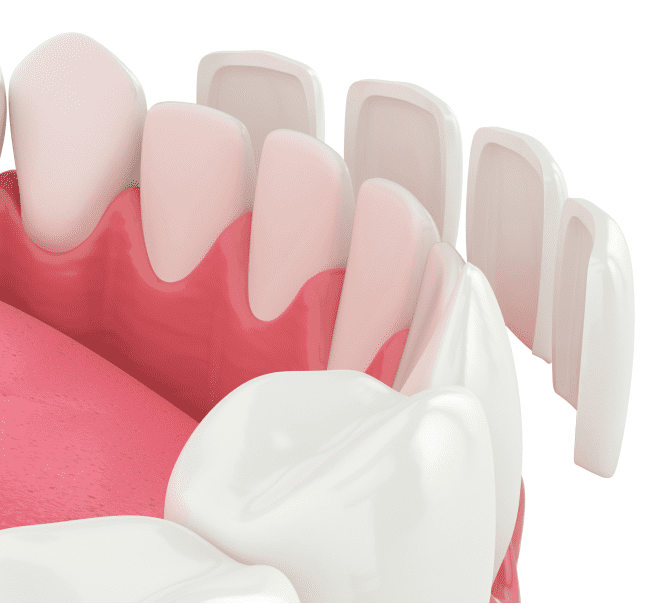Veneers can make your smile pretty — but do they cost a pretty penny too?
There’s no questioning the popularity of veneers in this city: they’re one of the hottest cosmetic treatments year after year, but the lead up to treatment always starts with one question: how much do veneers cost in Los Angeles?
Here’s the answer: the average all-in cost for a veneer is between $1,000 and $2,000.
That’s a big range, so to help you understand what’s going on, I’ve put together this explainer.
It goes through all of the individual cost factors, showing you what you can control, what you can’t control, and how to find great value as you’re comparing your options.
In this article:
- The veneers costs you can’t control
- Pretreatments
- Scans & Impressions
- Appointments
- The veneers costs you can control
- Veneer Material
- Number of Veneers
- Ways to make veneers more affordable
- Insurance
- Financing
- Everything recapped in 5 sentences
- How to get free personalized veneers advice
Just looking for your veneers cost?
You could guess using online info. Or you could get a FREE personalized quote with us.
The Veneers Costs You Can't Control
Pre-veneer Treatments
If you’re going to get veneers, you want to do everything you can to make sure the treatment is successful and problem-free. Depending on your oral health, that might mean going through a couple of other treatments before you get veneers.
As complete dental treatments on their own, these can add hundreds to thousands of dollars to the cost of getting veneers, so it’s really important to understand which (if any) pre-treatments you’ll need to get as you’re budgeting for veneers.
Some of the most common procedures people get before veneers are:
Orthodontics
While it’s possible to get Invisalign or braces after veneers, if you know your teeth need to be realigned, I always recommend getting veneers after. Orthodontic treatment can put extra stress on your veneers and shorten their lifespan.
Oral Hygiene Care
Veneers can block access to the gums to treat gum disease, and poor oral hygiene can shorten the lifespan of a veneer, so if you have one or both issues, it’s better to address them before placing your veneers.
Root Canals
If there’s a lot of damage or decay on a tooth that you want to put a veneer on, that tooth will need to be cleaned and restored before it can receive the veneer. If that doesn’t happen, the veneer won’t bond properly with the tooth.
Teeth Grinding
Like your natural teeth, grinding will wear down your veneers, shortening their lifespan and forcing you to replace them sooner than you would otherwise have to.
Digital Impressions & Scans

There’s an art to creating natural, realistic smiles with dental veneers, but there’s also a lot of science and technology.
The 3D mockups, the wearable smile preview, even the veneers themselves — so much of the modern veneers process starts with digital scans.
Why am I talking about all this in relation to the cost of your veneers?
Because all of these amazing things are potential items on your treatment invoice, of course.
Just to be clear: you won’t be able to pick and choose the scans you receive when you visit a dental office for veneers; all of that is part of the treatment process.
But what you will be able to do is ask the dentist about the role that technology plays in your treatment, and get them to explain how the scans you pay for are helping you get the amazing smile you want.
Those are questions that any dentist should be able to answer, and if they don’t have time for it or just avoid responding…well, maybe it’s time to look elsewhere.
Appointments
Getting veneers takes a few appointments. Aside from the actual placement of your veneers, there’s the consultation, impressions, preparation, plus refinements to get the look and fit exactly right. Depending on the dentist you see, you could end up being charged extra for all, some, or none of those appointments (and those charges can really add up quickly).
So how can you find out what you’re paying for?
By asking for an itemized treatment breakdown up front, and – especially for veneers – finding out whether there’ll be additional charges if you need to come back for more adjustments.
As always, cheaper isn’t always better, and premium pricing doesn’t always mean higher quality.
Those extra charges might absolutely be worth it if you’re getting a higher level of care or extra attention to detail — it’s up to you to talk to the dentist, read reviews, and do your homework to really understand if you’re getting value out of each appointment.
Nobody likes extra fees.
So we got rid of them. Our veneer prices are all-inclusive: what you see is what you pay.
The Veneers Costs You Can Control
Veneer Material
As you might’ve guessed, the cost of your veneers also depends on the material they’re made out of.
You almost always have a choice over the type of material you want for your veneers, and – at least as of 2022 – you have three choices: porcelain, composite, and same-day composite.
Porcelain
This used to be the only option if you wanted to get veneers, but now porcelain veneers are more of a premium choice.
Which means, yes, it’s the most expensive material of the three, but a lot of people still feel like the extra cost is worth it.
Why? Because porcelain can recreate that slightly see-through, translucent appearance that natural teeth have, and – once it’s bonded to your teeth – porcelain is practically as strong, durable, and stain-resistant as a natural tooth would be.
Composite
Compared to porcelain veneers, composite veneers are more of a “mid-tier” option.
Sometimes called resin veneers, they mix porcelain with other materials to create a hybrid material that makes veneers faster to create and easier to sculpt while still being strong.
These advantages make composite veneers more affordable than porcelain veneers, but they aren’t as durable and some people feel like they don’t look as natural either.
Same-day Composite
Same-day composite veneers are the most affordable option — but there’s a catch.
Instead of being pre-formed in a lab based on digital scans of your mouth and teeth, these veneers are created by hand.
That lets you get veneers more quickly, but there are downsides to go along with that. Since they don’t have the same digital precision,
these veneers tend not to look as nice, and are usually weaker compared to porcelain or lab-formed composite veneers.
My advice? If you want a major smile makeover but are on budget, don’t go for this type of veneer — there’s a good chance you’ll regret it.
The upfront price might be lower, but the results won’t last as long and you probably won’t be 100% satisfied with them.
Number of Veneers

The total cost of your veneers depends on how many you get.
Now, before you roll your eyes and think, “I don’t need someone with a dentistry degree to figure that out” — I promise that the statement isn’t quite as painfully obvious as it sounds.
Yes, if you get more veneers, your total cost will be higher. But, depending on the dentist you work with, your cost per veneer may actually be lower thanks to volume pricing.
Let’s do some math with a couple of imaginary dental offices:
| 4 veneers | 6 veneers | |
|---|---|---|
| Dental office with volume pricing | $4000 = $1000/veneer | $6000 = $1000/veneer |
| Dental office without volume pricing | $4800 = $1200/veneer | $5400 = $900/veneer |
Keep in mind that veneer patients, on average, get at least 6 veneers — that’s the number it usually takes to achieve a really noticeable transformation. So, if you’re looking for value, it’s often a smart idea to budget slightly more but also aim for a higher number of veneers.
It’s a win-win: you’ll lower the cost per veneer, and you’ll be happier with the end result, too.

Can insurance lower the cost of veneers?
Unfortunately, no, it can’t.
That’s just the way things are with dental insurance and benefits. Since they don’t cover cosmetic treatments, veneers aren’t eligible.
Are there other ways to save?
Sort of. Financing can’t help you pay a lower cost, but it can help you spread out your payments and make getting veneers easier when you’re on a budget.
For example, if you have a bit of money left over each month to invest in yourself, an option like CareCredit’s interest-free payment plan can make fitting the cost of veneers into your budget practically effortless.
Let’s review:
Generally, veneers in Los Angeles average out to $1000 – $2000 per veneer once all the other costs are factored in.
- If you need another dental treatment before you can get veneers, your costs will go up significantly.
- You can’t change the cost of appointments or scans, but they’re great ways to check the value you’re getting, as well as a dentist’s commitment and transparency.
- You can directly affect the cost of your veneers through the material that you choose and the number of veneers you get.
- Since veneers are cosmetic, dental benefits or insurance won’t help you save; options like interest-free financing can make the treatment more affordable instead.
Want to chat about getting your veneers in Los Angeles?
For a decision this big, it only makes sense to talk to a dental professional, ask around, and make sure you’re 100% educated before you make up your mind.
If there’s something you’d like to find out about, like how dental bonding compares to veneers, or the types of issues veneers fix, I’d be happy to chat with you about it.
Oh, and since we just reviewed costs, don’t worry — you can set up a virtual consultation or book a time to come in, it’s all totally free, zero commitment.
You’ll be free to ask anything you want about veneers, and I’ll give you my 100% honest professional advice. See you soon!
